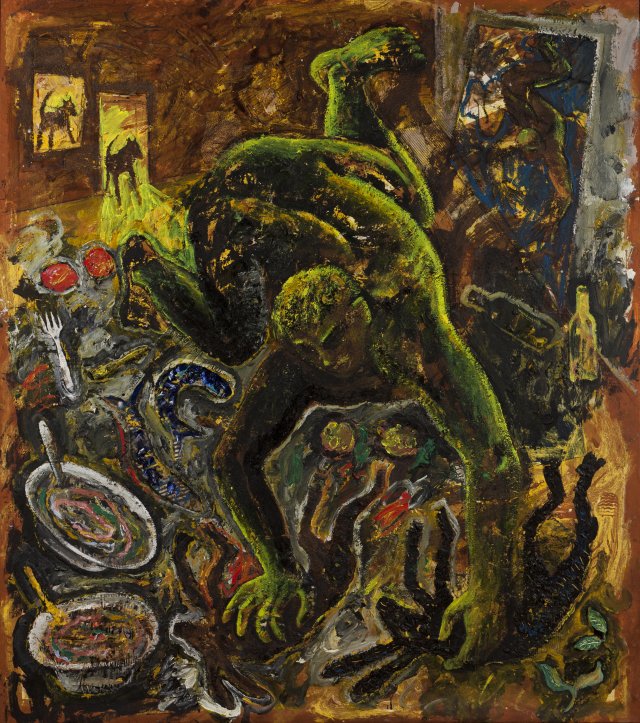32
"El pintor dentro del cuadro"
Miquel Barceló (b. 1947)
Estimate
Price on request
Session
1 June 2021
Description
Mixed media on canvas
Signed and dated Setembre 1983 Porto Colom on the reverse
230x204 cm
Category
Modern and Contemporary Art
Additional Information
Exhibitions:
"En el Centro", Centro Cultural de la Ciudad de Madrid, Madrid, Spain, 1984, Cat. p. 27.
Provenance:
Galeria Juana de Aizpuru, Madrid, Spain;
Private Collection, Portugal.
Lot Essay by Enrique Juncosa, Writer and Curator
This painting, executed in the artist's studio in Porto Colom (Mallorca) at the time, belongs to a remarkable group of works produced in the early 1980s, when the artist's international recognition began, and whose subject is the painter at work in his studio. In all of them, we see the painter's body represented within the painting he is painting, as in “El pintor amb el seu reflexe” (1982); “Peintre peignant le tableau”; “El pintor damunt el cuadre”, in the collection of Les Abbattoirs, Toulouse; “Hamlet”; or “Jugement de Salomon”, in the Pompidou collection in Paris (the last four works from 1983). Before painting them, Barceló had seen Caravaggio's “Narcissus”, a work that interested him in particular when he discovered it in a retrospective of the great Italian artist at the Metropolitan Museum of Art in New York. Narcissus, a figure from the Greek mythology, was a very beautiful young man, with whom everyone fell in love, and who, due to his arrogance, was condemned to fall in love with his own reflection seen in a pond, ultimately drowning as he lunged for his image. Caravaggio's painting presents the figure looking at his inverted reflection. Barceló paints painters confined within the paintings they are painting, suggesting that the act of painting has a narcissistic quality, being also a kind of spell and condemnation, forming an obsessive activity that allows no escape. Another work from 1983, “Le Buffet”, is very similar in composition to “El pintor dentro del cuadro”. The painters portrayed in both works are naked and upside down, in exaggerated positions, almost crawling across the surface of the paintings they are working on, suggesting contortionist or gymnastic exercises and absolute dedication.
They have something of the arachnids, and of superheroes such as Spiderman, and that inhabit graphic worlds that we might call mannerist. At this time, Barceló was also interested in the drawings of Pontormo and Michelangelo, who drew figures in such forced positions that they even result in extravagant, dramatic and violent figures. The painters of “El pintor dentro del cuadro” y “Le Buffet”, in any case, are surrounded by food, bottles, plates and cutlery, suggesting that painting, like food, is nourishing and necessary for life, and also that everyday life is transformed into something heroic by being painted. In “El pintor dentro del cuadro” everything is repeated twice. In the upper right-hand corner, we see a painting that could well be a mirror, for in it we see another figure in the same position as the dominant figure in the centre of the work. This central figure holds a hare in each hand, and around him we see two dogs, one painted in a painting and a similar one on the threshold of the studio door, and also two tomatoes, two blue fish, two soup dishes with spoons, or two bottles. The things, rather than painted, look like three-dimensional objects placed on the canvas, a metaphor for a parallel world which is a doubling of reality. Everything has a circular and dynamic movement, suggested by the curves of the body and its moving limbs, almost forming a helix.
The largest and most dominant images in the composition, the painter and the two hares, are black, but silhouetted by intense shades of green and yellow, which give them a sense of volume and create an overall dreamlike or hallucinatory atmosphere, perhaps not unlike that found in Miró’s famous “Naturaleza del zapato Viejo” (1937) in the MoMA collection in New York. This work also suggests a hallucinated vision of different everyday objects. Barceló, like Miró, does not pursue a mere representation of reality, but investigates the very nature of vision and perception, converted into tools that turn the painting into a form of knowledge in itself, as Music or Poetry can be. The dramatic, shadowy light in this painting by Barceló also recalls Mannerist and Baroque painting. Another of Barceló’s frequent themes, the paradoxical transformation of the thickness of matter into light and transparency, is also visible in this work, where the aforementioned colours and light create deep, vibrant spaces, with some electrifying forms.
Closed Auction



